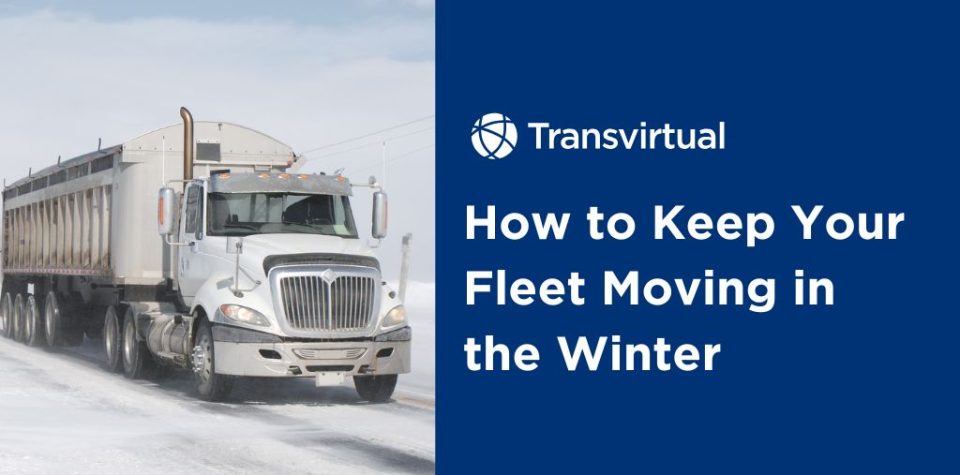Table of Contents
Winter is one of the most challenging seasons for fleet operations.
Snowstorms, icy roads, freezing temperatures and reduced daylight hours can disrupt schedules, create hazardous driving conditions and increase maintenance costs. These conditions demand proactive planning and strategic adjustments to maintain efficiency, ensure driver safety and meet delivery commitments.
Understanding the types of delays caused by the winter weather is the first step you can take to mitigate their impact. Explore the common winter-related delays fleet professionals face, followed by actionable strategies to keep operations running smoothly.
Common Winter-Related Delays in Fleet Operations
Winter weather can introduce several types of delays that disrupt your fleet’s operations:
- Weather-induced road closures and slowdowns: Snow, ice and freezing rain can make roads treacherous, leading to accidents, traffic congestion and road closures. Some regions may enforce temporary travel bans or restrictions for large trucks during severe storms.
- Vehicle mechanical failures: Cold weather affects vehicle components, leading to increased mechanical issues. Batteries can strain and lose efficiency, and tires can experience pressure fluctuations. If vehicles are not properly winterized, breakdowns become more frequent.
- Logistics and supply chain disruptions: Winter weather can delay shipments, disrupt supply chains and create scheduling conflicts. Port closures, airport delays and supply shortages can also make keeping fleet schedules on track difficult.
- Driver safety concerns: Snow-covered and icy roads increase the risk of skidding and accidents, leading to potential injuries, vehicle damage and delays. Reduced visibility from snowstorms or fog further exacerbates these risks.
- Fuel inefficiency: Cold weather causes engines to work harder, reducing fuel efficiency and increasing operating costs. Excessive idling to keep drivers warm also contributes to fuel waste.
- Limited daylight hours: Shorter days reduce the window for safe driving, especially for long-haul truckers operating in regions with strict daylight-only travel regulations.
How to Mitigate Winter-Related Delays in Fleet Operations
You can take several proactive measures to navigate winter challenges and minimize disruptions.
Use Technology to Manage Winter-Related Delays
Investing in technology can significantly improve winter preparedness and response. Some of the most effective tech solutions include:
- Telematics and GPS tracking: Advanced telematics provide real-time data on vehicle location, speed and conditions. Fleet managers can monitor weather patterns and reroute vehicles to avoid hazardous areas.
- Automated weather alerts: Integrated weather tracking systems provide up-to-date alerts, helping dispatchers make informed routing decisions.
- Predictive maintenance software: AI-powered maintenance tools analyze vehicle performance and predict potential failures before they occur, reducing downtime.
- Fleet management platforms: Cloud-based software helps coordinate fleet movements, track schedules and communicate with drivers in real time.
Winterize Fleet Vehicles to Prevent Breakdowns
Proper vehicle maintenance is crucial to avoiding winter-related breakdowns. Fleet managers should implement the following measures:
- Check battery health regularly: Ensure all batteries are tested and replaced if necessary before winter.
- Monitor tire pressure: Cold air reduces tire pressure, leading to poor traction. Keep tires inflated to the recommended PSI for optimal grip.
- Use winter-grade fuel and additives: Diesel fuel can gel in freezing temperatures, so using cold-weather fuel blends and anti-gelling additives can prevent engine issues.
- Install engine block heaters: In extreme cold, block heaters keep engines from freezing and make cold starts easier.
- Keep emergency kits in all vehicles: Equip trucks with blankets, food, water, flashlights, flares, tire chains and traction mats in case of emergencies.
Optimize Route Planning and Scheduling
Routing strategies are crucial in minimizing winter-related delays. Fleet operators should:
- Use dynamic routing software: AI-powered route optimization tools adjust plans in real time based on weather, traffic and road closures.
- Schedule flexible delivery windows: Build buffer times into schedules for unexpected delays.
- Avoid high-risk routes: Identify roads prone to closures, icy conditions or heavy snowfall and plan alternative routes.
Monitor Fuel Efficiency and Reduce Unnecessary Idling
Excessive idling drains fuel, increases costs and contributes to vehicle wear. To optimize fuel efficiency:
- Implement automatic engine shut-off systems: Many modern trucks have idle-reduction technology to prevent unnecessary fuel consumption.
- Encourage proper warmup times: Engines only need a few minutes to warm up before driving.
- Use auxiliary power: These systems provide heating and electricity without running the main engine.
Maintain Clear Communication With Drivers and Dispatchers
Real-time communication is critical for ensuring driver safety and responding to unexpected delays. Fleet managers should:
- Use fleet communication apps: Platforms like Samsara or Geotab enable instant messaging between drivers and dispatch.
- Provide daily weather briefings: Send weather and route updates each morning so drivers can prepare accordingly.
- Encourage drivers to report hazards: Immediate reporting of icy roads, accidents or blocked routes helps the entire fleet adjust.
Train Drivers for Safe Winter Driving
Driver preparedness is key to avoiding accidents and delays. Your company should conduct winter-specific training, covering:
- How to drive in snow and ice: Teach drivers safe following distances, proper braking techniques and how to handle skidding.
- Emergency response protocols: Train drivers on what to do if they get stranded or involved in a winter-related accident.
- Recognizing signs of driver fatigue and cold stress: Educate drivers on symptoms of hypothermia and fatigue, emphasizing the importance of regular breaks and proper winter gear to stay warm and alert.
- Pretrip inspections: Require drivers to check tire pressure, fluid levels and defrosters before hitting the road.
Partner With Third-Party Logistics and Road Maintenance Services
Collaborating with third-party providers can help your fleets stay ahead of winter disruptions. Strategies include:
- Contracting with snow removal services: Ensure fleet yards and parking areas are cleared of snow and ice.
- Working with weather forecasting companies: Services that provide real-time, fleet-specific weather alerts can help dispatchers make informed routing decisions.
- Coordinating with local authorities: Stay updated on road closures and travel restrictions by communicating with DOT officials.
Staying Ahead of Winter Challenges in Fleet Operations
Winter-related delays in your fleet’s operations can disrupt supply chains, increase costs and pose safety risks. However, by implementing proactive strategies — including leveraging technology, winterizing vehicles, training drivers, optimizing routes and maintaining clear communication — you can minimize disruptions and maintain operational efficiency.
Preparation is the key to successful winter fleet management. Investing in the right technology, enforcing preventive maintenance, and equipping drivers with the necessary tools will keep your fleets moving safely and efficiently throughout the coldest months.


